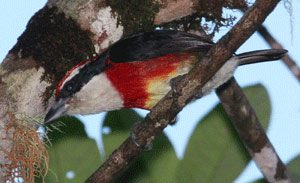New Bird Species Discovered in Peru, Named for Cornell Lab Director
August 6, 2012A colorful, fruit-eating bird with a black mask, pale belly, and scarlet breast—never before described by science—has been discovered and named by Cornell University graduates following an expedition to the remote Peruvian Andes. The Sira Barbet (Capito fitzpatricki) is described in a paper published in the July 2012 issue of The Auk, the official publication of the American Ornithologists’ Union. A painting of the barbet is featured as the issue’s cover illustration.
The new species was discovered during a 2008 expedition led by Michael G. Harvey, Glenn Seeholzer, and Ben Winger, young ornithologists who had recently graduated from Cornell at the time. They were accompanied by coauthor Daniel Cáceres, a graduate of the Universidad Nacional de San Agustín in Arequipa, Peru, and local Ashéninka guides.
The team discovered the barbet on a ridge of montane cloud forest in the Cerros del Sira range in the eastern Andes. Steep ridges and deep river gorges in the Andes produce many isolated habitats and microclimates that give rise to unique species.
Mike Harvey was first to see the new species on October 8, 2008. “It was sitting about 60 feet up on a bare branch,” he said. “At first we thought it was the Scarlet-banded Barbet (Capito wallacei), but the more we looked at it, the more we saw obvious differences in its plumage.”
Though clearly a sister species of the Scarlet-banded Barbet, the Sira Barbet is readily distinguished by differences in color on the bird’s flanks, lower back, and thighs and a wider, darker scarlet breast band. By comparing mitochondrial DNA sequences of the new barbet to DNA sequences of its close relatives in the genus Capito, the team secured genetic evidence that this is indeed a new species in the barbet family (Capitonidae). The genetic work was done by coauthor Jason Weckstein at The Field Museum in Chicago.
The team chose the scientific name of the new species, Capito fitzpatricki, in honor of Cornell Lab of Ornithology executive director Dr. John W. Fitzpatrick, who discovered and named 7 new bird species in Peru during the 1970s and 1980s.
“Fitz has inspired generations of young ornithologists in scientific discovery and conservation,” says Ben Winger. “He was behind us all the way when we presented our plan for this expedition.”
The 2008 expedition was made possible by funding from a special gift to the Cornell Lab of Ornithology and donations to the Lab’s student World Series of Birding team, Rawlings Cornell Presidential Research Scholars, National Geographic Young Explorers’ Grant, and the Explorers Club. Since the discovery, Harvey and Seeholzer have enrolled as Ph.D. students at Louisiana State University, and Winger is a Ph.D. student at the University of Chicago.

All About Birds
is a free resource
Available for everyone,
funded by donors like you
American Kestrel by Blair Dudeck / Macaulay Library

